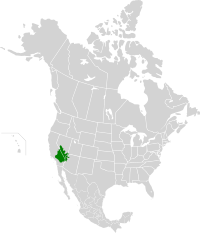| Mojave Desert Hayyikwiir Mat'aar (Mohave) Desierto de Mojave (Spanish) | |
|---|---|
 Sand dunes in Death Valley | |
 Location within North America | |
| Ecology | |
| Realm | Nearctic |
| Biome | Deserts and xeric shrublands |
| Borders | |
| Bird species | 230[1] |
| Mammal species | 98[1] |
| Geography | |
| Area | 81,000 km2 (31,000 sq mi) |
| Country | United States |
| States | |
| Coordinates | 35°N 116°W / 35°N 116°W |
| Rivers | Colorado River, Mojave River |
| Climate type | Cold desert (BWk) and hot desert (BWh) |
| Conservation | |
| Conservation status | Relatively Stable/Intact[2] |
The Mojave Desert (/moʊˈhɑːvi, mə-/ ;[3][4][5] Mohave: Hayikwiir Mat'aar;[6] Spanish: Desierto de Mojave) is a desert in the rain shadow of the southern Sierra Nevada mountains and Transverse Ranges in the Southwestern United States.[7][2] Named for the indigenous Mohave people, it is located primarily in southeastern California and southwestern Nevada, with small portions extending into Arizona and Utah.[8][2]
The Mojave Desert, together with the Sonoran, Chihuahuan, and Great Basin deserts, form a larger North American Desert. Of these, the Mojave is the smallest and driest. It displays typical basin and range topography, generally having a pattern of a series of parallel mountain ranges and valleys. It is also the site of Death Valley, which is the lowest elevation in North America. The Mojave Desert is often colloquially called the "high desert", as most of it lies between 2,000 and 4,000 feet (610 and 1,220 m). It supports a diversity of flora and fauna.
The 54,000 sq mi (140,000 km2) desert supports a number of human activities, including recreation, ranching, and military training.[9] The Mojave Desert also contains various silver, tungsten, iron and gold deposits.[10]: 124
The spelling Mojave originates from the Spanish language, while the spelling Mohave comes from modern English. Both are used today, although the Mojave Tribal Nation officially uses the spelling Mojave. Mojave is a shortened form of Hamakhaave, an endonym in their native language, which means "beside the water".[11]
- ^ a b "The Atlas of Global Conservation". maps.tnc.org. Archived from the original on March 5, 2012. Retrieved November 20, 2020.
- ^ a b c "Mojave desert". World Wildlife Fund. Retrieved November 20, 2020.
- ^ Jones, Daniel (2003) [1917]. Peter Roach; James Hartmann; Jane Setter (eds.). English Pronouncing Dictionary. Cambridge: Cambridge University Press. ISBN 978-3-12-539683-8.
- ^ "Mojave". Dictionary.com Unabridged (Online). n.d.
- ^ "Mojave". Oxford English Dictionary (Online ed.). Oxford University Press. (Subscription or participating institution membership required.)
- ^ Munro, P., et al. A Mojave Dictionary. Los Angeles: UCLA, 1992
- ^ "The Mojave Desert". Blue Planet Biomes.
- ^ "Mojave Desert". Encyclopædia Britannica. March 25, 2021. Retrieved July 22, 2021.
- ^ Cite error: The named reference
:2was invoked but never defined (see the help page). - ^ Cite error: The named reference
Dibbleewas invoked but never defined (see the help page). - ^ "Mojave Indian Fact Sheet". bigorrin.org. Retrieved March 9, 2022.